
- SAP Community
- Products and Technology
- CRM and Customer Experience
- CRM and CX Blogs by Members
- SAP CRM Middleware Overview with step by step conf...
- Subscribe to RSS Feed
- Mark as New
- Mark as Read
- Bookmark
- Subscribe
- Printer Friendly Page
- Report Inappropriate Content
- SAP Managed Tags:
- SAP Customer Relationship Management
SAP CRM Middleware Overview
Topics to be discussed
•Introduction
•BDOC introduction
•BDOC classes
•sBDOC(Synchronization BDOC)
•mBDOC(Messaging BDOC)
•Initial setup steps for BDOC
•BDOC monitoring steps
Introduction
•SAP has a very strong middleware tool when compared to other applications like Oracle where it is pretty easy for SAP CRM application to connect with and exchange data with other SAP Applications like SAP BW, SAP R/3 system etc. This connection and data transfer is established through middleware. From an ERP application perspective this is an extremely important aspect the data exchange among the systems is kind of back-bone and the crux of very existence of the application. This data exchange can be of following types between other systems and CRM:
1. Initial data transfer which is also called as Initial Load in SAP terminology
2. Intermediate synchronization of data among the applications also called as Delta Load in SAP terminology
3. Synchronization.
Introduction
•Just to throw some light on the kinds of data exchange mentioned above, it can be better understood if we look at the frequency of the data exchange. Initial load is primarily a one time activity wherein when the connectivity is established between the systems, the data is transferred from one system to another. This data can range from configuration data (like pricing conditions) to master data (like Business Partners and Products) to transactional data (like Sales Quotations, Contracts and Sales Orders).
•Delta load is an activity of intermediate data transfer among the systems. This activity takes place more often than not to keep the data in various systems in sync and also take care of the changes to details of the data in various systems. It also takes care of newly created data in the system and distributes the same to other connected applications. Primarily this takes place in real-time and is primarily done automatically.
Synchronization activity is to take care of any out of sync data. This may be a cause of connectivity failure or might as well be an outcome of maintenance activity. This is primarily done manually as and when needed.
SAP CRM Middleware in SAP CRM Architecture






sBDoc (Synchronization BDoc)
•Only used for data synchronization with mobile clients.
•sBDoc types contain direct mappings to tables of the consolidated database. sBDoc types are used to make data persistent in the CDB and to exchange messages between the CRM Server and mobile clients.
Realignment and dependencies between sBDoc types are supported.



Initial setup steps for BDOC
•Setting up of RFC connection
•Selection of Industry
•Maintain Default Customer Industry
•Generation of Industry specific objects
•Configuration of Publication, Sites and Subscription
•Define Middleware Parameters
•Registration of Destinations
•Registration of Inbound Queues
•Maintain Organization Unit Objects
•Maintain Object Number Ranges
•Set Up Objects Exchange
Steps involved in data exchange
•Start Initial Load
•Monitor Objects
•Setup Delta Load
•Create Synchronization Request
•Start Synchronization Request
•Monitor Synchronization Request









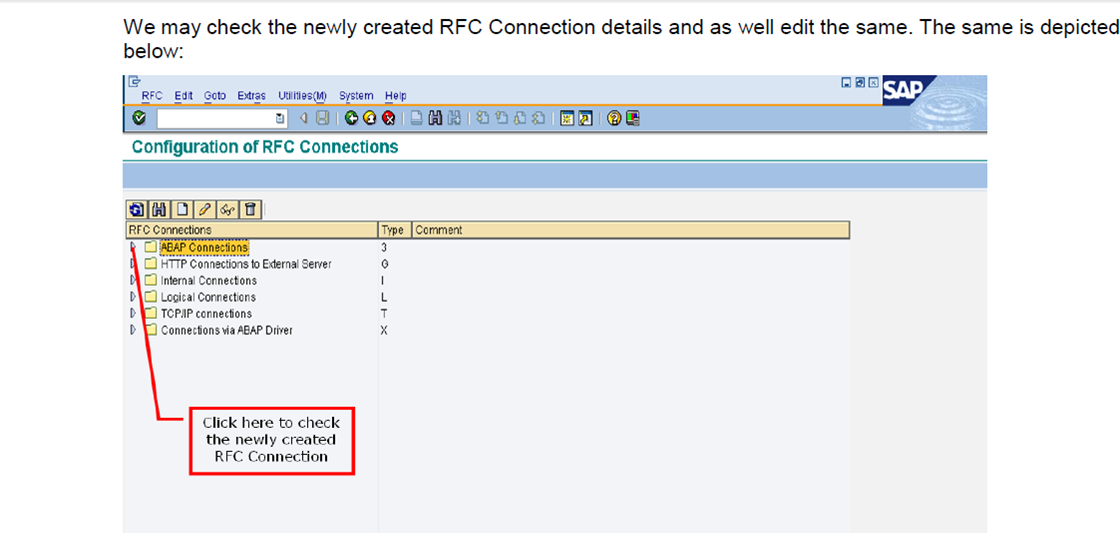

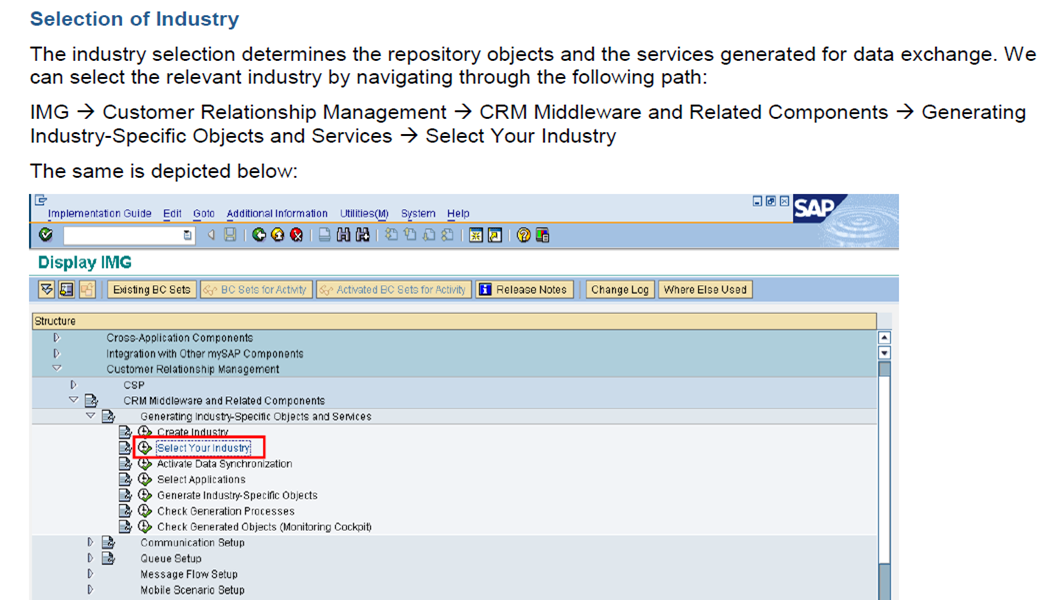


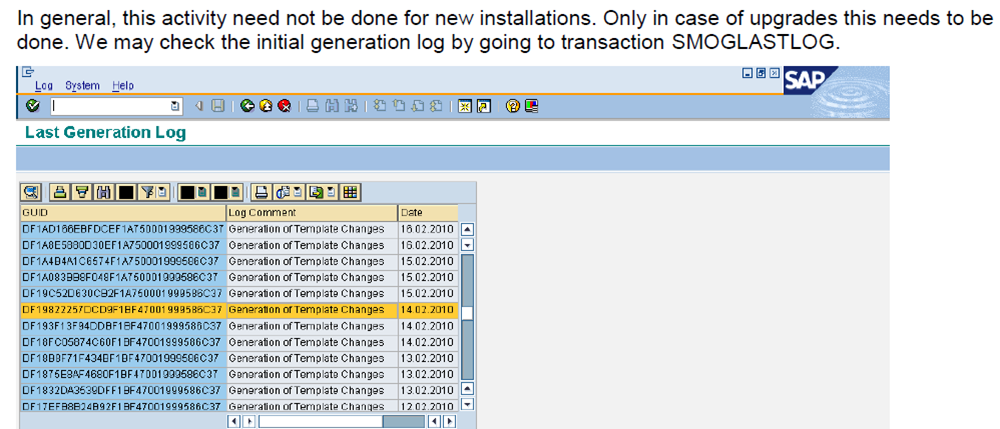





























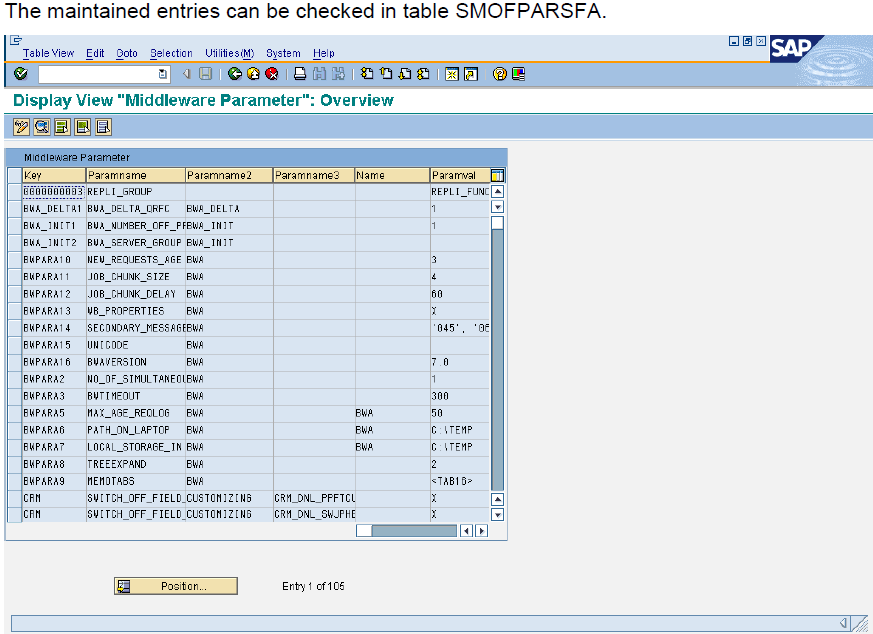




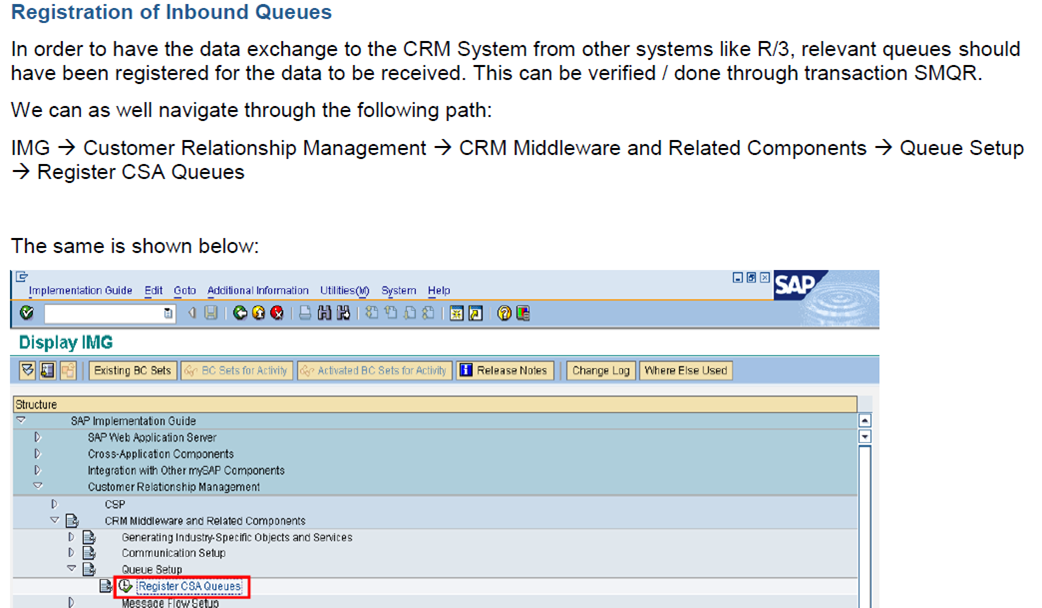















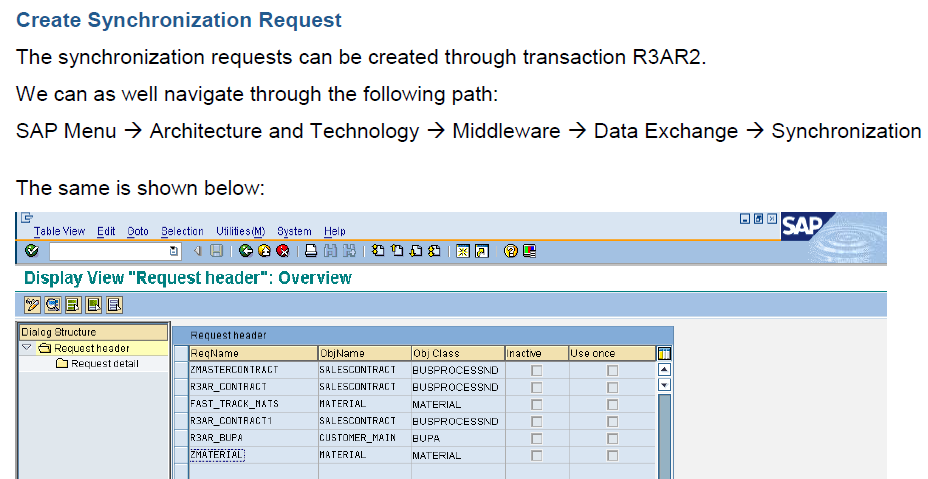






SAP CRM Middleware monitoring steps
•Firstly use SMW01 to monitor BDOCS to check whether there are any BDOCS in error
•Secondly check for inbound queues whether they are in error or no using transaction SMQ2
•thirdly check for inbound queues whether they are in error or no using transaction SMQ1
You must be a registered user to add a comment. If you've already registered, sign in. Otherwise, register and sign in.
-
"TypeScript" "Development" "FeedBack"
1 -
ABAP
1 -
adobe analytics
1 -
Advanced Filter in SAP C4C
1 -
Amazon CTI
1 -
API Rules
1 -
Automation in C4C
1 -
c4c
1 -
C4C Analytics
1 -
C4C Broadcast
1 -
C4C Broadcasts Report
1 -
C4C Extensibility
1 -
C4C Reporting
1 -
C4C Sales
4 -
C4C Sales and Service Cloud
1 -
C4C Service
2 -
C4C Service v2 Integration with S4 Hana utility
1 -
CAP development
16 -
clean core
14 -
clean-core
2 -
crm
4 -
CRM Business Transaction Event Framework
1 -
CRM Case Management
1 -
custom fields
1 -
custom fields and logic
1 -
Custom Key Metrics
1 -
Customer Data
2 -
datalayer
1 -
Datasource
1 -
Determination
1 -
Determinations
1 -
DocuSign
1 -
Enabling SDK Fields on Custom BO's OWL Screen
1 -
Enabling SDK Fields on standard OWL Screen
1 -
Enterprise Service Management (ESM)
1 -
ESM
1 -
Expert Insights
1 -
external terminal
1 -
google analytics
1 -
Introducing SAP Analytics Cloud
1 -
Introduction
1 -
javascript
1 -
Knowledge Article
1 -
Knowledge Base
1 -
Knowledge Sharing
1 -
KYMA
1 -
Kyma Functions
1 -
Logic
1 -
OBN
1 -
OBN Link C4C
1 -
open SAP
1 -
PDI
14 -
PFCG
1 -
promotions
1 -
RAP development
1 -
RFM
1 -
Sales and Service Cloud Version 2
1 -
Sales Cloud
1 -
Sales Cloud v2
1 -
SAP
1 -
SAP Cloud Applications Studio
1 -
SAP Cloud Platform Integration
1 -
SAP Community
1 -
SAP CPQ
1 -
SAP CRM Web UI
1 -
SAP Customer Checkout
3 -
SAP Customer Data Cloud
1 -
SAP Customer Data Platform
2 -
SAP Customer Experience
1 -
SAP CX
17 -
SAP CX Cloud
16 -
SAP CX extensions
16 -
SAP Emarsys Customer Engagement
1 -
SAP Emarsys Predict
1 -
SAP Emarsys Smart Insight
1 -
SAP Enterprise Service Management (ESM)
2 -
SAP ESM
1 -
SAP Integration Suite
1 -
SAP Odata
1 -
SAP S4 Hana
1 -
SAP S4 Hana Public Cloud
1 -
SAP Sales Cloud
3 -
SAP Sales Cloud v1
16 -
SAP Sales Cloud v2
19 -
SAP Service Cloud
17 -
SAP Service Cloud v2
17 -
SAP Service Cloud Version 2
1 -
SAP Utilities
1 -
Saving Search Queries on OWL Screen
1 -
Service and Social ticket configuration
1 -
Service Cloud v2
1 -
side by side extensibility
14 -
side-by-side extensions
2 -
Technical article
1 -
Ticket configuration in SAP C4C
1 -
Transport Management
1 -
Validation
1 -
Validations
1 -
web extend
1
- SAP Customer Checkout 2.0 Feature Pack 21 (Released OCTOBER-2024) in CRM and CX Blogs by SAP
- Integrating Amazon Connect with SAP Service Cloud V2 in CRM and CX Blogs by Members
- Integrating SAP CX AI Toolkit with SAP Commerce Cloud in CRM and CX Blogs by SAP
- Uncover the Power of SAP Commerce Workflow Management with Our Tutorial Video in CRM and CX Blogs by SAP
- SAP Product Inspiration Series for Industries & Intelligent CX (Wave #4) in CRM and CX Blogs by SAP